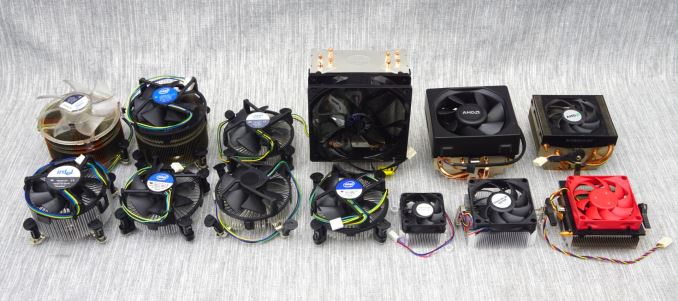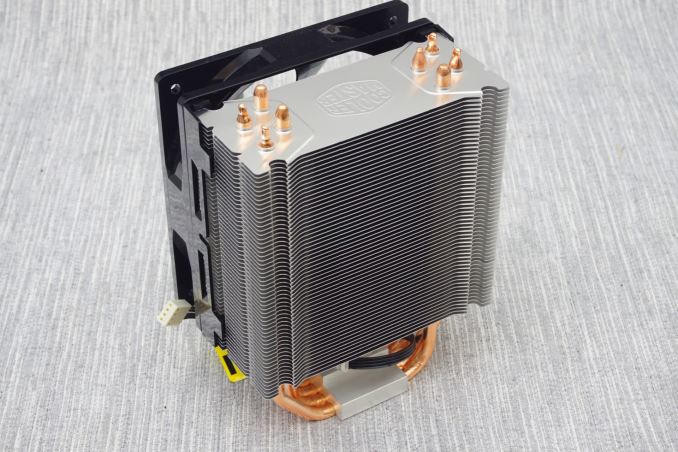Battle of The CPU Stock Coolers! 7x Intel vs 5x AMD, plus an EVO 212
by E. Fylladitakis on July 22, 2016 9:00 AM EST- Posted in
- Cases/Cooling/PSUs
- CPUs
- AMD
- Intel
- Cooler Master
- Cooler

Advanced PC users that like to care for their system commonly believe stock cooling solutions that are supplied with processors to be either barely adequate or too noisy even for a standard, unmodified system operating at stock frequencies. With bulk PC orders it is, of course, a difference scenario when every penny counts. But as a result of the perception of poor cooling from these 'default' coolers, most enthusiast users seek aftermarket cooling solutions. This has created a vast and multivariate demand, and there are so many companies offering such a wide variety of cooling products, from $20 all the way up to custom water cooling solutions. But is that really necessary for a mid-range build? We gathered together around a dozen stock coolers from across the years, from AMD and Intel, and pitted them against the highly rated EVO 212 from Cooler Master.
Introduction
Modern CPUs have become more efficient over time, and have begun to have lower cooling requirements. As a result, the CPU manufacturers have designed some rather advanced stock coolers and are either supplying them alongside their top-tier CPUs or selling them as aftermarket solutions. Despite the fact that these are the 'certified' coolers for the processors, the CPU manufacturer has to make millions, to every hundredth of a cent in manufacturing can be important to the bottom line. It is not easy for the average user to assess just how good the stock cooler really is and how much of an improvement, if any at all, there will be from the purchase of an aftermarket cooler. End users need to be aware of the performance of their current cooling solutions in order to reasonably assess the upgrade that will fit their needs.
In this review we will showcase the thermal performance of some popular stock CPU coolers of the last few years, including the controversial aftermarket Intel BXTS15A and the highly touted AMD Wraith. We also included one of the most popular mainstream coolers available, the Cooler Master EVO 212, as a baseline comparison against aftermarket solutions.
The coolers that we will be testing are in the following table, along with core/fin material listed, the size of the fan, and the overall mass of the cooler as measured on our units. Where heatpipes are in play, these are added into the Core section.
| Vendor | Cooler | Common Bundle | Core | Fins | Fan (mm) |
Mass (g) |
| Intel | D75716-002 | Socket 775 Celerons | Alu | Alu | 80 | 118 |
| C25704-002 | Socket 775 P4 6x0 | Cu | Alu | 80 | 132 | |
| E97378-001 | Socket 1155 Intel i5 | Cu | Alu | 80 | 146 | |
| E97379-001 | Socket 1155 Intel i3 | Alu | Alu | 80 | 92 | |
| D60188-001 | Socket 775, C2D E8x00 | Cu | Alu | 80 | 419 | |
| E31964-001 | Socket 1366 i7-X | Cu | Cu/Alu | 100 | 435 | |
| BXTS15A | Aftermarket, ≈$30 | Cu | Alu | 80 | 362 | |
| AMD | 1A213LQ00 | AMD “Kabini” AM1 | Alu | Alu | 50 | 75 |
| FHSA7015B | Several AMD Lines | Alu | Alu | 70 | 164 | |
| AV-Z7UB408003 | Black Edition Phenom | Alu +2 Cu HP |
Alu | 70 | 374 | |
| Wraith (125W) | AMD FX-8370 AMD A10-7890K |
Cu +4 Cu HP |
Alu | 90 | 304 | |
| Cooler Master | HK8-00005 | AMD FM2+ “Godavari” CPUs | Alu | Alu | 70 | 125 |
| EVO 212 | Aftermarket, ≈$30 | Cu +4 Cu HP |
Alu | 120 | 436 |











82 Comments
View All Comments
Cygni - Friday, July 22, 2016 - link
You thought that's what this comparison was about? Really? People swapping stock coolers? REALLY?SetiroN - Friday, July 22, 2016 - link
You don't get sarcasm even when explicitly pointed out? REALLY?ImSpartacus - Sunday, July 24, 2016 - link
I've got a 212 in my machine and I nearly went stock, so this is an absolutely fantastic comparison in my opinion.Very unique & helpful article, overall. It's amazing how such a simple topic can be so deceptively useful.
cknobman - Monday, July 25, 2016 - link
The point of the entire article was to provide information for someone that wanted to use the stock cooler.Heck I'm rocking a 212 myself because I cannot see spending more $$$.
Now if AMD would only bundle a processor worthy of the freaking cooler I might buy one!!!
blackmagnum - Friday, July 22, 2016 - link
Tip: Don't forget to clean the fans once in a while.fanofanand - Friday, July 22, 2016 - link
I think there is one tiny component here that was overlooked, and that is ease of installation. The stock coolers are FAR simpler to install, weigh significantly less, and therefore cause less stress on your motherboard. That isn't a big deal when you have a high-end ROG board or the like, but on cheaper, thinner motherboards not having 400+ grams hanging off the side is pretty nice.ZeDestructor - Friday, July 22, 2016 - link
Have you ever used push-pins? I personally abhor pushpin coolers - damn thing doesn't go into the board half the time and results in needing 4 tries (including cleaning and reapplying TIM) before the damn thing is in....Honestly, I'd pay the extra cost of a half-decent cooler like a Noctua NH-L9x65 or Cryorig M9i just so I can use a bunch of simple, solid screws instead.
PS: even OEMs agree - their coolers are just the reference intel coolers, but with screws and an as-cheap-as-possible backplate to screw into.
jabber - Friday, July 22, 2016 - link
I detest the push pins too. Just cant get on with them.Zap - Saturday, July 23, 2016 - link
Push pins are super simple to use once you figure them out. You can't just place the heatsink on top of the CPU and mash down the pins. That's the path to tears and frustration. I've installed hundreds of them, and can nail the install in one try. They are secure enough that you can pick up the motherboard using the heatsink and wave it around.What you do is to guide the pins until they go through the holes in the motherboard and the base (translucent white part) is sitting flush against the motherboard. THEN you press down on the black pins until they click. Go diagonally, as you would installing wheels on your car. For the first pin, you'll have to hold down the heatsink so it doesn't tilt.
ZeDestructor - Sunday, July 24, 2016 - link
It's a royal pain to line the cooler up when the board is installed in the case since you have no lateral or underside vision to see that the pins are lined up before you can push in, so you basically guesstimate where it is based on pin movement, find it feels like it's in the hole, press down on the pin... aaaaand crunch! Now, you swear some oaths about the bloody moron who designed the damn thing as you find that you've successfully crushed half of the pin out of the hole, making the bloody thing even more annoying to line up successfully blind.No, I'll stick to 4 zinc-plated steel screws tyvm.